|
|
|
Sort Order |
|
|
|
Items / Page
|
|
|
|
|
|
|
| Srl | Item |
| 1 |
ID:
192044
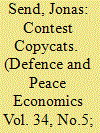

|
|
|
|
|
| Summary/Abstract |
Participants in an innovation contest may steal their opponents’ ideas to enhance their chance of winning. To model this, I introduce the ability to copy another player’s effort in a Tullock contest between two players. I characterise the unique equilibrium in this game dependent on the cost of copying and one of the players’ productivity advantage. If the cost of copying is low, the less productive player is more likely to win the contest. The model’s comparative statics have important implications for governments who subsidise firms in contests and for contest designers.
|
|
|
|
|
|
|
|
|
|
|
|
|
|
|
|
| 2 |
ID:
162783
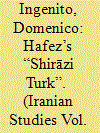

|
|
|
|
|
| Summary/Abstract |
This article constitutes a preliminary attempt to explore the geographical dimension of premodern Persian lyric poetry from the perspective of the relationship between the historical adherence of a text to external reality and the rhetorics of intertextuality and performativity. The pretext for this exploration is the poem known as “Tork-e Shirazi” or “The Turk from Shiraz,” one of the most celebrated ghazals of Hafez of Shiraz. The analysis focuses in particular on the first two lines of the ghazal, whose rich and ambiguous imagery has challenged the community of readers, interpreters, and scholars for centuries. On the basis of historiographical, formalist, and poststructuralist approaches to the study of lyric poetry, the article outlines a generative paradigm that analyzes a given text from the perspective of its abstract, genre-specific, conventionally negotiated, and referential levels of meaning. The contribution of geocritical studies will be combined with rhetorical analysis to conceive of Hafez’s text as a geopoetic map in which the cities of Shiraz, Samarkand, and Bukhara are put in conversation with the mental and historical representations of Iran and India between the thirteenth and fourteenth centuries, during the transition from the Mongol to the Timurid models and ideals of power.
|
|
|
|
|
|
|
|
|
|
|
|
|
|
|
|
| 3 |
ID:
060530
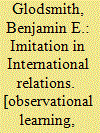

|
|
|
|
|
| Publication |
New York, Palgrave Macmillan, 2005.
|
| Description |
xviii, 166p.
|
| Standard Number |
1403967806
|
|
|
|
|
|
|
|
|
|
|
|
Copies: C:1/I:0,R:0,Q:0
Circulation
| Accession# | Call# | Current Location | Status | Policy | Location |
| 049496 | 327.47009049/GOL 049496 | Main | On Shelf | General | |
|
|
|
|
| 4 |
ID:
158563
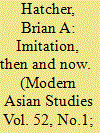

|
|
|
|
|
| Summary/Abstract |
The goal of this article is to provide conceptual and historical orientation useful for thinking about the emergence of philanthropy in modern South Asia. Conceptually, the article suggests the need to approach the expression of philanthropy in early colonial Bengal in terms of processes of imitation. To do so, we must overcome the stigma attached to the idea of imitation within both nationalist and post-colonial thought. In the particular context of early colonial Calcutta, local actors entered into intimate relationships with Europeans and these relationships provided occasions to borrow, translate, and retool a range of ideas and practices relevant to new modes of public charity. The importance of attending to historical context is suggested by reading such early colonial developments against the grain of late nineteenth-century perspectives—a time when Bengalis grew anxious about cultural imitation. Rather than deferring to these late-colonial anxieties over imitation, we need to situate them within a critically informed historical framework. To do this, the present article draws on the writings of the Brāhmo intellectual Rajnarain Bose, who pondered the relationship between an earlier colonial moment (‘then’) and his own late-colonial ‘now’. Close reading of Bose allows us to plumb the nature of late-colonial anxiety about cultural borrowing while opening up a new perspective on imitation and intimacy in early colonial Bengal that is not predicated on the teleology of the late-colonial modern.
|
|
|
|
|
|
|
|
|
|
|
|
|
|
|
|
| 5 |
ID:
100258
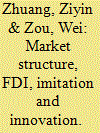

|
|
|
|
|
| Publication |
2010.
|
| Summary/Abstract |
We develop an extended North-South model to analyse the US-China IPRs conflict and possible policies. In our model, innovation in the North (US), imitation in the South (China), and Foreign Direct Investment (FDI) are all endogenous. We predict that whether tighter IPRs benefit the US or China depends crucially on market structure. In an oligopoly market induced by vertical innovation, tighter IPRs hurt both economies; while, in a monopolistic competition market induced by horizontal innovation, tighter IPRs benefit both economies as long as the degree of IPRs is appropriately chosen. We prove the existence of an optimal degree of IPRs protection in China, which may differentiate it from that in the US.
|
|
|
|
|
|
|
|
|
|
|
|
|
|
|
|
| 6 |
ID:
167580
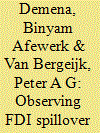

|
|
|
|
|
| Summary/Abstract |
We observe and analyse three intra-industry foreign direct investment (FDI) spillover transmission channels using unique firm-level data collected from on-site interviews and observations regarding domestic and foreign firms operating in Uganda in 2015. Our main results are: (1) the spillover effects mainly depend on the channel(s) by which they occur (the competition channel is most important while spillover benefits through the worker mobility and the imitation channels are less prevalent) and (2) both positive and negative spillover effects occur within the same channel and, moreover, effects differ by channel for the same case. These are novel and challenging findings that have not yet been recognised in theoretical and empirical research on FDI spillovers. Our results suggest that long-term pecuniary spillover effects are predominantly stimulated via the competition channel and show that only limited short-term and long-term technological spillover effects occur through the imitation and the movement of workers channels. These channels are not only less prevalent, but also appear to be constrained by competition-determined spillovers. We are confident that these directions for future research will have a high pay-off because, as shown by this exploratory fieldwork, a more complete picture of the spillover effects is reached when the channels are considered simultaneously.
|
|
|
|
|
|
|
|
|
|
|
|
|
|
|
|
| 7 |
ID:
182571
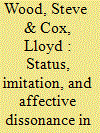

|
|
|
|
|
| Summary/Abstract |
This article explores the interplay of status, imitation and affective dissonance in international relations. Some states and nations selectively imitate others to correct perceived status deficits. Over time imitation can diminish ideals of group distinctiveness and independence from models and norm-setters, stimulating a condition we term affective dissonance. This complex of processes underlies some tensions in contemporary world politics. We apply the propositions to case studies of Russia and China whose leaders assert themselves as the principal loci and prescribers of national authenticity.
|
|
|
|
|
|
|
|
|
|
|
|
|
|
|
|
|
|
|
|
|